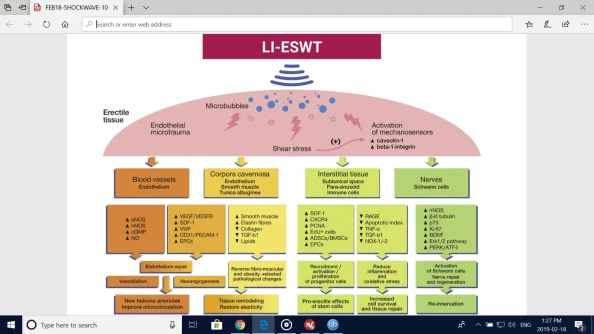madman
Super Moderator
The Basic Science Behind Low-Intensity Extracorporeal Shockwave Therapy for Erectile Dysfunction: A Systematic Scoping Review of Pre-Clinical Studies
Ioannis Sokolakis, MD, PhD, MSc, Fotios Dimitriadis, MD, PhD, Pearline Teo, PhD, Georgios Hatzichristodoulou, MD, PhD, Dimitrios Hatzichristou, MD, PhD, and Francois Giuliano, MD, PhD
ABSTRACT
Introduction: Despite recent promising clinical results, the underlying mechanism of action of low-intensity extracorporeal shockwave therapy (Li-ESWT) for erectile dysfunction (ED) is mostly unclear and currently under investigation.
Aim: To systematically identify and evaluate evidence regarding the basic science behind Li-ESWT for ED, discuss and propose a putative mechanism of action, address the limitations, and imply insights for further investigation in the field.
Methods: Using Cochrane’s methodologic recommendations on scoping studies and systematic reviews, we conducted a systematic scoping review of the literature on experimental research regarding Li-ESWT for ED and other pathologic conditions. The initial systematic search was carried between January and November 2017, with 2 additional searches in April and August 2018. All studies that applied shockwave treatment at an energy flux density >0.25 mJ/mm2 were excluded from the final analysis.
Main Outcome Measure: We primarily aimed to clarify the biological responses in erectile tissue after LiESWT that could lead to improvement in erectile function.
Results: 59 publications were selected for inclusion in this study. 15 experimental research articles were identified on Li-ESWT for ED and 44 on Li-ESWT for other pathologic conditions. Li-ESWT for ED seems to improve erectile function possibly through stimulation of mechanosensors, inducing the activation of neoangiogenesis processes, recruitment and activation of progenitor cells, improving microcirculation, nerve regeneration, remodeling of erectile tissue, and reducing inflammatory and cellular stress responses.
Clinical Implications: Improving our understanding of the mechanism of action of Li-ESWT for ED can help us improve our study designs, as well as suggest new avenues of investigation.
Strengths & Limitations: A common limitation in all these studies is the heterogeneity of the shockwave treatment application and protocol.
Conclusion: Li-ESWT for ED, based on current experimental studies, seems to improve erectile function by inducing angiogenesis and reversing pathologic processes in erectile tissue. These studies provide preliminary insights, but no definitive answers, and many questions remain unanswered regarding the mechanism of action, as well as the ideal treatment protocol.
CONCLUSIONS
Li-ESWT seems to improve impaired erectile function in a variety of animal models of ED, possibly through stimulation of mechanosensors, inducing the activation of neoangiogenesis processes, recruitment and activation of progenitor cells, improvement of microcirculation, nerve regeneration, remodeling of erectile tissue with increase in the muscle/collagen ratio, and reducing inflammatory and cellular stress responses. These studies provide preliminary insights but no definitive answers, and many questions remain unanswered regarding the mechanism of action, the experimental setting for testing Li-ESWT, as well as the ideal treatment protocol.
Ioannis Sokolakis, MD, PhD, MSc, Fotios Dimitriadis, MD, PhD, Pearline Teo, PhD, Georgios Hatzichristodoulou, MD, PhD, Dimitrios Hatzichristou, MD, PhD, and Francois Giuliano, MD, PhD
ABSTRACT
Introduction: Despite recent promising clinical results, the underlying mechanism of action of low-intensity extracorporeal shockwave therapy (Li-ESWT) for erectile dysfunction (ED) is mostly unclear and currently under investigation.
Aim: To systematically identify and evaluate evidence regarding the basic science behind Li-ESWT for ED, discuss and propose a putative mechanism of action, address the limitations, and imply insights for further investigation in the field.
Methods: Using Cochrane’s methodologic recommendations on scoping studies and systematic reviews, we conducted a systematic scoping review of the literature on experimental research regarding Li-ESWT for ED and other pathologic conditions. The initial systematic search was carried between January and November 2017, with 2 additional searches in April and August 2018. All studies that applied shockwave treatment at an energy flux density >0.25 mJ/mm2 were excluded from the final analysis.
Main Outcome Measure: We primarily aimed to clarify the biological responses in erectile tissue after LiESWT that could lead to improvement in erectile function.
Results: 59 publications were selected for inclusion in this study. 15 experimental research articles were identified on Li-ESWT for ED and 44 on Li-ESWT for other pathologic conditions. Li-ESWT for ED seems to improve erectile function possibly through stimulation of mechanosensors, inducing the activation of neoangiogenesis processes, recruitment and activation of progenitor cells, improving microcirculation, nerve regeneration, remodeling of erectile tissue, and reducing inflammatory and cellular stress responses.
Clinical Implications: Improving our understanding of the mechanism of action of Li-ESWT for ED can help us improve our study designs, as well as suggest new avenues of investigation.
Strengths & Limitations: A common limitation in all these studies is the heterogeneity of the shockwave treatment application and protocol.
Conclusion: Li-ESWT for ED, based on current experimental studies, seems to improve erectile function by inducing angiogenesis and reversing pathologic processes in erectile tissue. These studies provide preliminary insights, but no definitive answers, and many questions remain unanswered regarding the mechanism of action, as well as the ideal treatment protocol.
CONCLUSIONS
Li-ESWT seems to improve impaired erectile function in a variety of animal models of ED, possibly through stimulation of mechanosensors, inducing the activation of neoangiogenesis processes, recruitment and activation of progenitor cells, improvement of microcirculation, nerve regeneration, remodeling of erectile tissue with increase in the muscle/collagen ratio, and reducing inflammatory and cellular stress responses. These studies provide preliminary insights but no definitive answers, and many questions remain unanswered regarding the mechanism of action, the experimental setting for testing Li-ESWT, as well as the ideal treatment protocol.
Attachments
-
[email protected]1.4 MB · Views: 274














